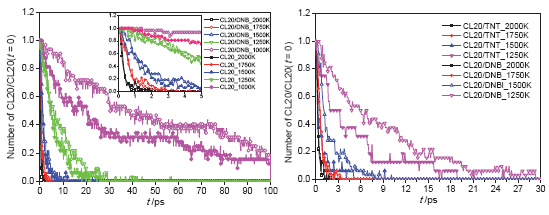| [1] Nielsen, A. T. US Appl. 07/253106, 1988.
[2] Nielsen, A. T.; Chafin, A. P.; Christian, S. L.; Moore, D. W.; Nadler, M. P.; Nissan, R. A.; Vanderah, D. J.; Gilardi, R. D.; George, C. F.; Flippen-Anderson, J. L. Tetrahedron 1998, 54, 11793.
[3] Simpson, R. L.; Urtiew, P. A.; Ornellas, D. L.; Moody, G. L.; Scribner, K.; Hoffman, D. M. Propellants Explos. Pyrotech. 1997, 22, 249.
[4] Ordzhonikidze, O.; Pivkina, A.; Frolov, Y.; Muravyev, N.; Monogarob, K. J. Therm. Anal. Calorim. 2011, 105, 529.
[5] Guo, C. Y.; Zhang, H. B.; Wang, X. C.; Sun, J. Mater. Rev. 2012, 26(10), 49 (in Chinese). (郭长艳, 张浩斌, 王小川, 孙杰, 材料导报, 2012, 26(10), 49.)
[6] Zhang, C. Y.; Cao, Y. F.; Li, H. Z.; Zhou, Y.; Zhou, J. H.; Gao, T.; Zhang, H. W.; Yang, Z. W.; Jiang, G. CrystEngComm 2013, 15, 4003.
[7] Bolton, O.; Matzger, A. J. Angew. Chem. Int. Ed. 2011, 50, 8960.
[8] Yang, Z. W.; Zhang, Y. L.; Li, H. Z.; Zhou, X. Q.; Nie, F. D.; Li, J. S.; Huang, H. Chin. J. Energ. Mater. 2012, 20, 674 (in Chinese). (杨宗伟, 张艳丽, 李洪珍, 周小清, 聂福德, 李金山, 黄辉, 含能材料, 2012, 20, 674.)
[9] Bolton, O.; Simke, L. R.; Pagoria, P. E.; Matzger, A. J. Cryst. Growth Des. 2012, 12, 4311.
[10] Sun, T.; Liu, Q.; Xiao, J. J.; Zhao, F.; Xiao, H. M. Acta Chim. Sinica 2014, 72, 1036 (in Chinese). (孙婷, 刘强, 肖继军, 赵峰, 肖鹤鸣, 化学学报, 2014, 72, 1036.)
[11] Wang, Y. P.; Yang, Z. W.; Li, H. Z.; Zhang, Q.; Wang, J. H.; Liu, Y. C. Propellants Explos. Pyrotech. 2014, 39, 590.
[12] Gong, X. B.; Sun, C. H.; Pang, S. P.; Zhang, J.; Li, Y. C.; Zhao, X. Q. Chinese J. Org. Chem. 2012, 32, 486 (in Chinese). (公绪滨, 孙成辉, 庞思平, 张静, 李玉川, 赵信岐, 有机化学, 2012, 32, 486.)
[13] Xu, X. J.; Xiao, J. J.; Huang, H.; Li, J. S.; Xiao, H. M. Sci. China Ser. B 2007, 50, 737.
[14] Isayev, O.; Gorb, L.; Qasim, M.; Leszczynski, J. J. Phys. Chem. B 2008, 112, 11005.
[15] Byrd, E. F. C.; Scuseria, G. E.; Chabalowski, C. F. J. Phys. Chem. B 2004, 108, 13100.
[16] Xu, X. J.; Xiao, H. M.; Ju, X. H.; Gong, X. D. Chin. J. Org. Chem. 2005, 25, 536 (in Chinese). (许晓娟, 肖鹤鸣, 居学海, 贡雪东, 有机化学, 2005, 25, 536.)
[17] Tian, Q.; Yan, G. Y.; Sun, G. G.; Huang, C. Q.; Xie, L.; Chen, B.; Huang, M.; Li, H. Z.; Liu, Y.; Wang, J. Cent. Eur. J. Energ. Mat. 2013, 10, 359.
[18] Golofit, T.; Zy?k, K. J. Therm. Anal. Calorim. 2015, 119, 1931.
[19] Liu, H.; Li, Q. K.; He, Y. H. Acta Phys. Sin. 2013, 62, 1 (in Chinese). (刘海, 李启楷, 何远航, 物理学报, 2013, 62, 1.)
[20] Liu, H.; Li, Q. K.; He, Y. H. Acta Phys. Sin. 2015, 64, 018201-1 (in Chinese). (刘海, 李启楷, 何远航, 物理学报, 2015, 64, 018201-1.)
[21] Furman, D.; Kosloff, R.; Dubnikova, F.; Zybin, S. V.; Goddard, W. A. J. Am. Chem. Soc. 2014, 136, 4192.
[22] Cheng, T.; Jaramillo-Botero, A.; Goddard, W. A.; Sun, H. J. Am. Chem. Soc. 2014, 136, 9434.
[23] Yang, Z.; He, Y. H. Acta Phys.-Chim. Sin. 2016, 32, 921 (in Chinese). (杨镇, 何远航, 物理化学学报, 2016, 32, 921.)
[24] Yang, Z.; Liu, H.; He, Y. H. Acta Phys. Chim. Sin. 2016, doi: 10.3866/PKU.WHXB201604293
[25] Diao, Z.; Zhao, Y.; Chen, B.; Duan, C. Acta Chim. Sinica 2012, 70, 2037 (in Chinese). (刁智俊, 赵跃民, 陈博, 段晨龙, 化学学报, 2012, 70, 2037.)
[26] http://lammps.sandia.gov/ (accessed Mar. 21, 2016).
[27] Gonzalez, A. C.; Larson, C. W.; McMilen, D. F.; Golden, D. M. J. Phys. Chem. 1985, 89, 4809.
[28] Fields, E.; Meyerson, S. J. Org. Chem. 1972, 37, 3861.
[29] Fang, M.; Li, Z.; Fu, Y. Chinese J. Chem. 2008, 26, 1122.
[30] Rice, B. M.; Sahu, S.; Owens, F. L. J. Mol. Struct. (Theochem). 2002, 583(1-3), 69.
[31] Shao, J. X.; Cheng, X. L.; Yang, X. D. Struct. Chem. 2006, 17, 547.
[32] Wang, G.; Gong, X.; Liu, Y.; Xiao, H. Chinese J. Chem. 2009, 27, 1669.
[33] Turcotte, R.; Vachon, M.; Kwok, Q. S. M.; Wang, R.; Jone, D. E. G. Thermochim. Acta 2005, 433(1-2), 105.
[34] Nair, U. R.; Sivabalan, R.; Gore, G. M.; Geetha, M.; Asthana, S. N.; Singh, H. Combust. Explos. Shock Waves 2005, 41, 121.
[35] Nedelko, V. V.; Chukanov; Raevskii, A. V.; Korsounskii, B. L.; Larikova, T. S.; Kolesova, O. I. Propellants Explos. Pyrotech. 2000, 25, 255.
[36] Meent, A.; Dittrich, B.; Johnas, S. K. J.; Thome, V.; Weckert, E. F. Acta Crystallogr. Sect. B: Struct. Sci. 2008, 64, 42.
[37] Wojcik, G.; Mossakowska, I.; Holband, J.; Bartkowiak, W. Acta Crystallogr. B 2002, 58, 998. |
